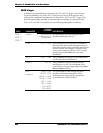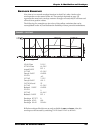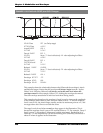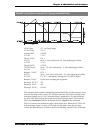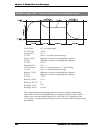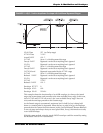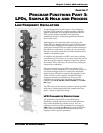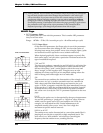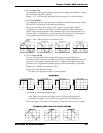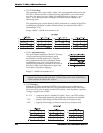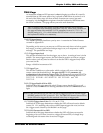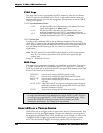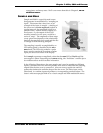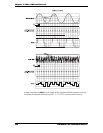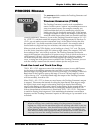
Chapter 7: LFOs, S&H and Process
172 ANDROMEDA A6 REFERENCE MANUAL
Tip: Tabbing feature: You can select any parameter simply by turning its correspond-
ing soft knob, but this action also changes the parameter’s value which isn’t
always desirable. If you just want to review the current settings of the LFO
parameters without changing anything, you can select a parameter without
changing its value by pressing its page’s soft button. For LFO pages (like the
Envelopes) pressing a soft button once selects the page, pressing it again selects
the parameter to the right of the active parameter in the Parameter Row.
Repeated pressings cycle though all parameters from left to right.
WAVE Page
➠ RATE Frequency Select
The speed of the LFO is set with this parameter. This is another LFO parameter
that you will use often.
Range: .0076Hz – 25 Hz (131.6 seconds per cycle – 40 milliseconds per cycle)
SHAPE Shape Select
Of the nine LFO parameters, the Shape select is one of the parameters
you’ll use most often when editing an LFO. You have the option of
selecting from among four periodic waves (sine, triangle, square/pulse
and sawtooth) and two aperiodic waves (random and noise).
When depicted graphically, these waveforms appear very much like
their names imply, and you select a particular waveform based on the
type of modulation required.
SINE and TRI
The sine wave produces a smooth rise and fall which is well-suited for
most vibrato applications. The triangle has a similar smooth rise and
fall but with a sharp ”peak” (on the positive side of the wave) and
sharp “trough” (on the negative side). Triangle waves are also
adequate for vibrato, especially at low amplitude settings where the
effect of sharp peaks and troughs aren’t as noticeable.
SAW
The sawtooth wave combines the characteristics of the triangle and
pulse waves. An "up" or positive sawtooth wave has a smooth rise
with a sharp peak that immediately drops and starts its rise cycle
again. A "down" or negative sawtooth falls, then immediately rises up
to the start level. Unlike the oscillators which have positive/negative
sawtooth waves to select from, in the LFOs the up/down character-
istic of the wave is set by the
PWIDTH parameter explained on the next
page.
PULSE
In contrast, the pulse wave is characterized by abrupt or instantaneous
rise and fall, producing a “push-pull” or “high-low” effect. When its
width is set to a square wave (50%) and routed to the VCOs, for
example, it is well-suited for trills. Careful adjustments to its
amplitude actually allow you to “tune” the wave’s high-low
movement to specific musical intervals.
RANDOM or NOISE
The random wave can be characterized as a wave that sounds like it’s
jumping all over the place, especially at high amplitude levels. The
noise wave is an “ultra-random” wave that has a much higher
frequency than the random wave, sounding like hiss.
BASIC LFO WAVESHAPES



